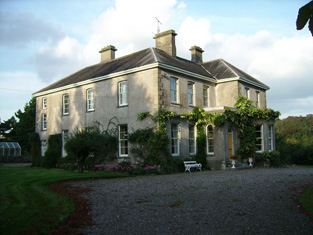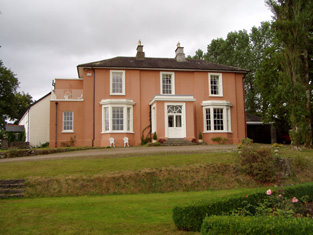Convamore
Houses within 5km of this house
Displaying 10 houses.
Houses within 5km of Convamore
Displaying 10 houses.
| House name | Description | |
|---|---|---|
| Convamore Upper | J. Delany was the proprietor of Upper Convamore in 1837. George Crofts occupied the house in the early 1850s. He held it from the Reverend G. Atkins Collins and it was valued at £16. The property was later bought by the Reverend Maurice Collis who sold it to the Earl of Listowel. Unoccupied for much of the 20th century it was demolished in 2000. | |
| Clifford | This house was occupied by Richard Martin in 1814 and by Thomas Lloyd in 1837 and at the time of Griffith's Valuation, when he held the property from Edward Beatty. The buildings were valued at £26. Clifford passed by marriage to the Mansergh family of Grenane, county Tipperary and at the time of the sale in 1879 was inhabited by Captain C.S. Mansergh, who held it on a lease dated 1868. The representatives of E. Charles Mansergh of Clifford owned 511 acres in county Tipperary in the 1870s. In 1942 the Irish Tourist Association survey reported that it was the residence of the Walton family nd that the estate had been reduced to 40 acres. This house was recently renovated. |

|
| Glenanore/Glananore | Part of this house appears to date from the early 18th century. It belonged to the Verling family, whose interest eventually became vested in the Johnson family. The Reverend Richard Purcell was the tenant in the latter part of the 18th century and Wilson refers to it as his seat in 1786. It was occupied in 1814 by Garret Nagle and by the early 1830s the Hoares were resident. At the time of Griffith's Valuation Mrs Mary Anne Hoare was the occupier, holding the property from Noble Johnson. The buildings were valued at £32. Mrs Hoare was the widow of Reverend Thomas Hoare who was a brother of Sir Joseph Wallis Hoare, 3rd Baronet. In 1942 the Irish Tourist Association Survey asserted that the front part had been constructed in the early nineteenth century but that other parts were much older. It was then the residence of E.J. Hoare and it was still occupied by members of the Hoare family in the 1950s but is now demolished. |

|
| Woodville | Woodville was occupied by the Reverend William Berkley in 1814 and in 1837 by Mrs Gibbons. Anne Gibbings was resident in the 1850s [widow of Bartholomew Gibbings of Gibbings Grove]. She held the property from Martha Jaunsey and the buildings were valued at £17.15 shillings. Her fourth son Robert Gibbings is described as "of Woodville" in Burke's Landed Gentry. A note on the sale rental of 1862 records the purchase of Lot 1 Woodville by Mr Starkey [Dr William Starkey]. The house remained in the possession of the Starkey family until the early 20th century. |

|
| Kilcummer | This would appear to have been a Wilson residence from the late 18th century though Wilson, writing in 1786, refers to it as the seat of "Mr. Groves". . Hajba writes of earlier associations with the Oliver, Cole Bowen and Grove families. Henry Cole Bowen was resident in 1750. At the time of Griffith's Valuation William Wilson was the occupier. He held the property from Benjamin Grubbs and it was valued at £10. In the 1870s William Wilson of Kilcummer owned 182 acres in county Cork. This house is no longer extant. | |
| Renny | This house, overlooking the River Blackwater, may have been part of the Widenham estate which passed to the Smyths. The site had earlier associations with the poet Edmund Spenser. Wilson, writing in 1786, refers to "Rinny, the seat of Mr. Nagle, which was formerly part of the estate of the immortal Spenser". In 1814 the Reverend C.P. Wallis was the occupant. At the time of Griffith's Valuation the house was occupied by Henry Smith who held the property in fee, the buildings were valued at £23. Henry Smyth advertised the house and 541 acres for sale in May 1851, all it required at that time was a "small outlay in paint and paper to make it at once fit for occupation". In 1885 Walford noted Renny as the seat of John Blackburne. Hajba writes that the last occupant was Captain [Pepper] Roberts. The Earl of Listowel demolished the house following the Captain's death in 1900 though many of the buildings shown on the 1st edition Ordnance Survey map had already disappeared by then. | |
| Castle Widenham [Blackwater Castle] | Originally a Roche stronghold, the castle was granted to the Widenhams in the mid 17th century. The castle was altered in both the 18th and 19th centuries. In the early 19th century it passed by marriage to the Brazier Creagh family and again by marriage to the Smyths. At the time of Griffith's Valuation the buildings were valued at £70 and held by Henry M. Smyth from Henry Leader. In 1894 it was the seat of Mrs. Smyth. In 1942 the Irish Tourist Association survey noted that it was still part of the Smyth family estate. Also known as Blackwater Castle, it is still extant. In 2022 it was offered for sale. |
![Photo of Castle Widenham [Blackwater Castle]](https://landedestates.ie/storage/img/orig/1571.jpg)
|
| Gurteen | Home of the Campion family in the first half of the 19th century held from the Earls of Listowel. Luke Campion was resident in 1837 and Lewis writes that it had "been greatly enlarged and improved". Mrs Mary Campion was resident in the early 1850s. The buildings were valued at £13.15 shillings. Later occupants were stewards to the Earl. The house was demolished in the early 20th century. | |
| Templenoe | Hajba writes that this house, on the banks of the River Blackwater, was built in 1761 by the Hydes of Castle Hyde. William Hyde (died 1790) of Templenoe was the son of John Hyde of Creg Castle and grandson of Arthur Hyde of Castle Hyde. He married Catherine Lane. William Lane Hyde was resident in 1837 and at the time of Griffith's Valuation. He held the property valued at £20 from John Phipps. His estate of 584 acres was advertised for sale in July 1850. The present Templenoe House was the residence of the Mounteagles in the latter half of the 20th century. |

|
| Rocksavage | This house was not built at the time of the first edition Ordnance Survey circa 1840. Built for John Craven Mansergh [in the 1850s] on land that formerly belonged to the Martin family. In 1942 the Irish Tourist Association Survey reported that Rocksavage was the residence of Dr. Foley. This house, situated close to the Awbeg River just south of Castletownroche, is still extant. |

